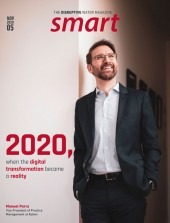By 2027, Australia, the driest inhabited continent and home to an urbanized population of approximately 25 million will deploy nearly ten million smart water meters on Narrow-Band IoT networks (NB-IoT), up from under 50,000 today. Most people understand the role of smart water meters. Less understood is the role global standards are playing in Australia's water management market.
Low-power wide-area networks (LPWAs) provide the bi-directional connectivity needed to operate smart water meter solutions. There are many LPWAs, each with a unique value proposition.Australia is an interesting use-case because the vast majority of smart water meters will use NB-IoT. NB-IoT is the only LPWA based on a global, homogenized standard. According to research from the Global Mobile Suppliers Association's (GSMA) there are 140 operators in 69 countries.
NB-IoT’s Global Role
Globally available, NB-IoT meets smart water metering's technical and strategic requirements. Smart water meters have ten plus year lifespans, use batteries, and are adapted to specific networks. NB-IoT operated by multinational telecoms best addresses questions of risk and perennity. Transparent, decreasing connectivity costs increases the ability of businesses to forecast costs. Australia has two NB-IoT operators enhancing competition and quality-of-service. Finally, behind NB-IoT deployments are massive economies-of-scale. ABI Research predicts, modules, the building blocks of smart water meters, will drop in price to $1.98 by 2024.
Smart meters are not easy to build. An early focus on costs, including energy-efficiency and field-service costs, is key to success
Enter Lightweight M2M
NB-IoT checks the right boxes, but in Australia, another global standard, Lightweight M2M 1.1 (LwM2M), is also at work. LwM2M 1.1 is a device management standard proposed by the Open Mobile Alliance. OMA SpecWorks board members, including ARM, AT&T, Ericsson, IoTerop, Itron, T-Mobile, and Qualcomm, have worked tirelessly to create a standard that addresses smart metering challenges. Smart meters are not easy to build, requiring much forethought and optimization. An early focus on costs, some obvious, some less so, including energy-efficiency and field-service costs, are key to success.
Cost effectively supporting millions of remote, constrained objects requires device management services that limit human interventions, privileging virtual interventions. LwM2M 1.1 provides everything needed to commission, deploy, and operate devices securely with just a mouse. What happens when a device arrives from the factory or behaves atypically? Competent organizations will replace the security credentials. With LwM2M 1.1, changing security credentials, like firmware updates, another requirement, is done remotely. Standardized data models assure interoperability, future-proofing investments. Seventy objects exist for the water industry, with others for device management. Any LwM2M compliant device or server will work with another. Think IoT plug-and-play.
Conclusion: Global Standards Ensure Value and Risk Management
Smart water meters perform better and cost just a fraction of mechanical water meters from a generation ago. Although costs are decreasing, deployments still represent significant investments. Standards like NB-IoT and LwM2M 1.1 provide needed functionality while addressing the strategic issues of openness and interoperability. The market and analysts are taking note.
Technology analyst Gartner in their June 2020 report Hype Cycle for IoT Standards and Protocols says, "NB-IoT is an ideal use case for LightweightM2M…LwM2M is important for simplifying IoT cellular application development…Investing in NB-IoT is a low-risk strategy.” In Australia, the vast majority of smart water tenders now mandate NB-IoT and LwM2M to assure deployments meet functional, operational, and strategic requirements today and into the future.





